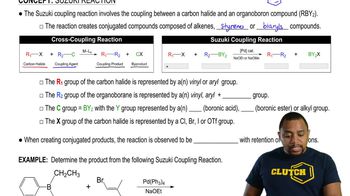Here are the essential concepts you must grasp in order to answer the question correctly.
Suzuki Coupling Reaction
The Suzuki coupling reaction is a widely used method in organic chemistry for forming carbon-carbon bonds. It involves the reaction of an aryl or vinylic halide with an alkenylorganoboron compound in the presence of a palladium catalyst and a base. This reaction is particularly valuable for synthesizing complex organic molecules due to its ability to create diverse structures with high selectivity.
Recommended video:
Aryl and Vinylic Halides
Aryl halides are compounds where a halogen atom is bonded to an aromatic ring, while vinylic halides have a halogen atom attached to a carbon-carbon double bond. Both types of halides are important substrates in various organic reactions, including the Suzuki reaction. Their reactivity is influenced by the stability of the resulting intermediates and the nature of the halogen, which affects the overall efficiency of the coupling process.
Recommended video:
How to name alkyl halides
Alkenylorganoboron Compounds
Alkenylorganoboron compounds are organoboron species that contain a carbon-carbon double bond. They serve as nucleophiles in the Suzuki reaction, reacting with electrophilic aryl or vinylic halides to form new carbon-carbon bonds. The presence of the boron atom allows for the formation of stable intermediates, facilitating the coupling process and making these compounds essential for synthesizing complex organic molecules.
Recommended video:

 Verified step by step guidance
Verified step by step guidance Verified Solution
Verified Solution



 4:02m
4:02m